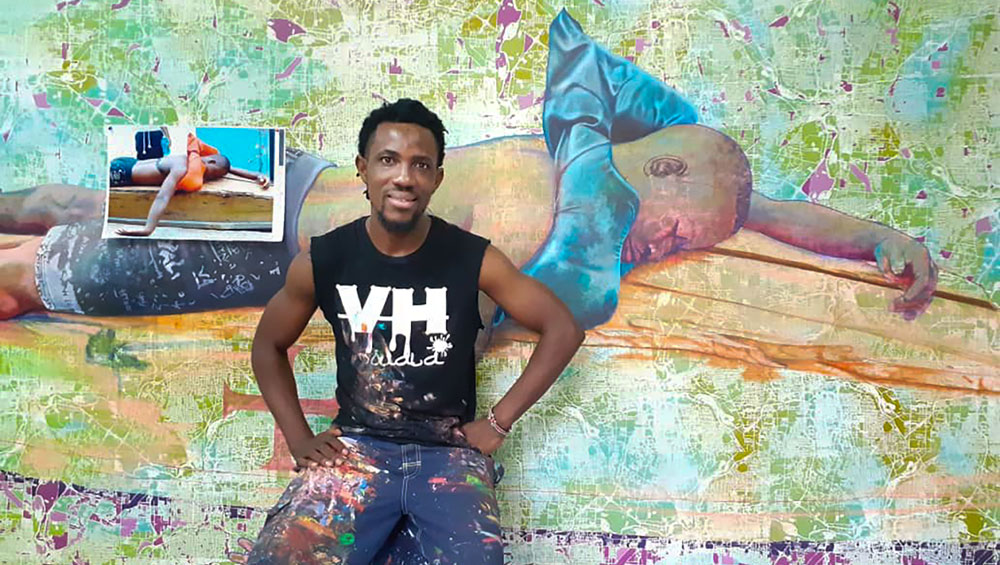
Jean David Nkot. Courtesy AFIKARIS Gallery.
by ANNA McNAY
Jean David Nkot (b1989, Douala, Cameroon) has been working with AFIKARIS Gallery – dedicated to promoting artists from Africa and its diaspora – since it began as a virtual platform in 2018. Now, his first major solo show in France is the inaugural show in the gallery’s new Parisian space. Nkot knows the French capital from his time there on a master’s course, following his undergraduate studies in Cameroon, to where he later returned and remains to this day.
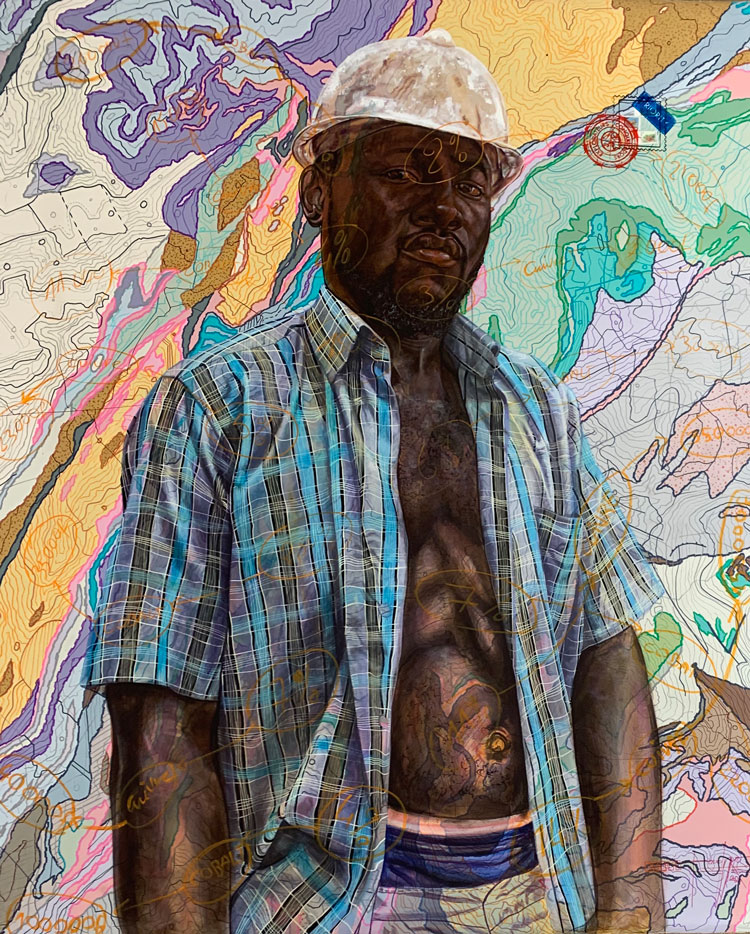
Jean David Nkot. PO.Box.Tarification #Cobalt #Cuivre.org, 2020. Acrylic and posca on canvas, 206 x 174 cm. Courtesy AFIKARIS Gallery.
Concerned with the human condition, Nkot works with layers to build up meaning in his mixed-media paintings, telling the story of the subject depicted as well as the wider narrative of the place in which they live – although sometimes, out of necessity, he allows a native of one country to take on and “tell” the story of another. Currently preoccupied with the mismanagement of raw materials and the mining industry in Africa, Nkot seeks to show the strength and resilience of the people he portrays, not just their suffering.
Inspired by the maps of the Swiss artist Thomas Hirschhorn, Nkot builds up layers of terrain, portraiture and data or symbols – his so-called “molecule maps” – to create his complex and deeply fascinating finished works. In the run up to his exhibition, Nkot spoke to Studio International via email about the ideas behind each layer, how his practice has developed, and what he hopes to provoke as an audience response.
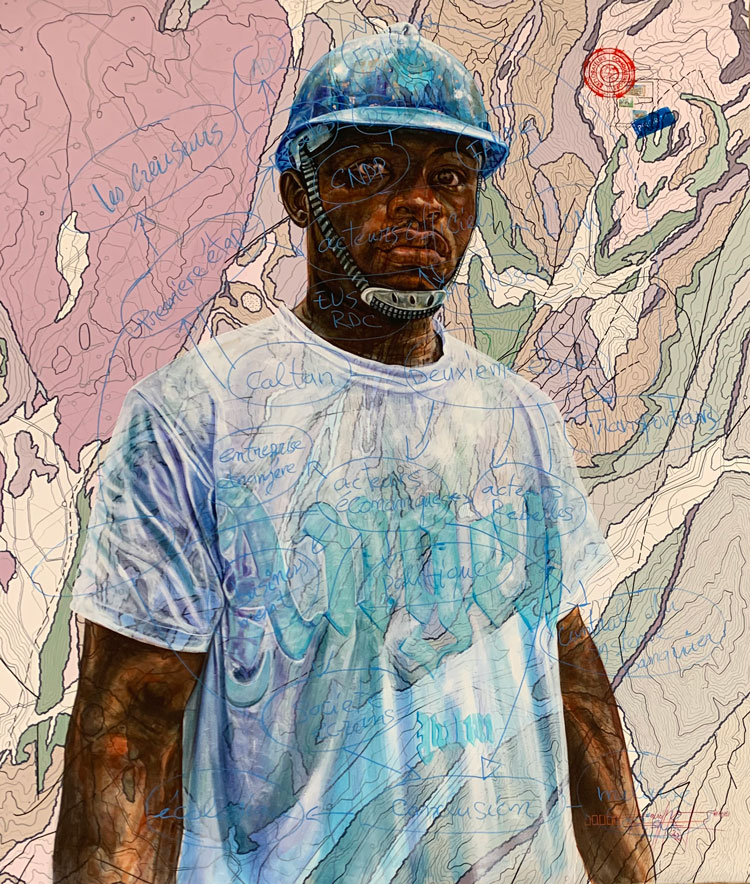
Jean David Nkot. www.jeux // enjeux.com, 2020. Acrylic and posca on canvas, 206 x 174 cm. Courtesy AFIKARIS Gallery.
Anna McNay: Tell me a little about the series of works you are showing in Human@Condition, your first major solo show in France, and the inaugural exhibition for AFIKARIS Gallery, in its new, non-virtual space in Paris. You call the paintings “molecule maps”, and they comprise three layers or informational planes: a broad cartography, a network of data and then your superimposed human subjects. Where did the idea for this layering come from, and what does each layer represent?
Jean David Nkot: The works on display in Human@Condition bear witness to the evolution of my practice; from a technical point of view, as well regarding the topics I address. While I used to draw my characters first and then apply the pattern of the map around them, I now paint the portraits directly on top of the cartography. The transparency created leaves more room to focus on the main message. Also, whereas my early works used to focus on the topic of migration as a means to depict the human condition, the pieces featured in Human@Condition deal with the theme of mining. Here, rather than highlighting pain and sorrow, I focus on the resilience of the people I represent. I’m interested in the moments of joy, and I capture the smiles behind the suffering. I praise the self-sacrifice and strength of these anonymous individuals.
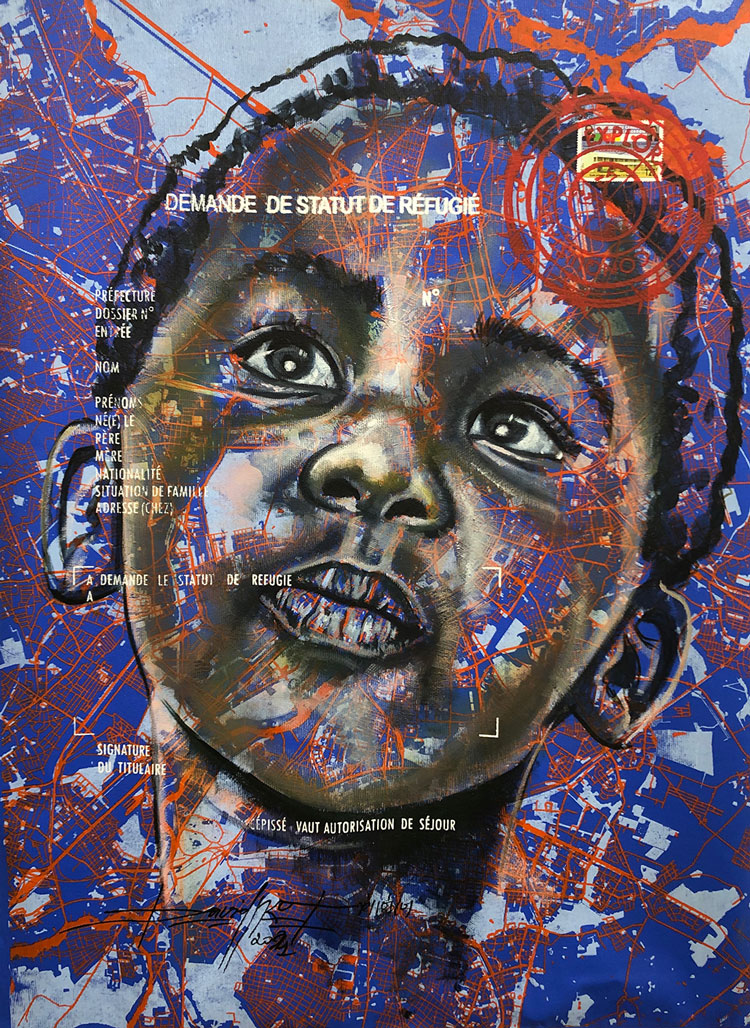
Jean David Nkot. www.look of hopes@.com #8, 2021. Acrylic, posca and silkscreen printing on canvas, 65 x 50 cm. Courtesy AFIKARIS Gallery.
These “molecule maps” call to mind the structure of molecules and atoms by circling and linking key ideas together. This concept is inspired by the maps of the Swiss artist Thomas Hirschhorn. This third layer supports and enriches the story being told behind the canvas with data. While the map embodies the territory and the portrait depicts the human body, the network of data, superimposing the other two layers, is a way to illustrate the fight of the body against the territory. I want to show how the bodies manage to be integrated within a space that is not favourable to them.
AMc: Why have you referred to the works as “molecule maps”?
JDN: The concept, as I mentioned, was inspired by the maps created by Hirschhorn. Like him, I circle keywords and link them together. I call them molecule maps, or maps molécules, because of their structure. Information gravitates around a central word. I want to show how they can generate a debate around a specific topic. It is normal if, at first sight, this mass of information does not seem clear or fully coherent.
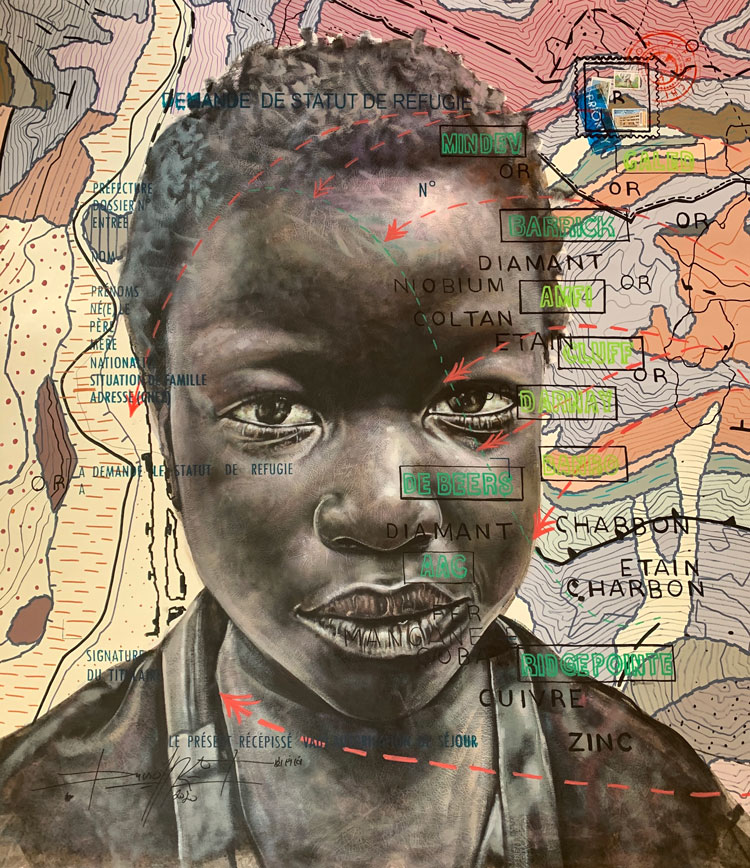
Jean David Nkot. BP. Child of Calabar, 2020. Acrylic, Indian ink and posca on canvas, 120 x 110 cm. Courtesy AFIKARIS Gallery.
AMc: Can you also say a little about the exhibition title, Human@Condition, and the significance of the “@” as a link between the two words? Also, the human condition is such an immense subject. What especially about it draws you in, and what are you focusing on?
JDN: The notion of the human condition is one guiding principle in my art. Thus, this seemed an inherently good title for this new body of work. I imagine each canvas as a message sent to the world. Accordingly, I make references to the postal industry and new communication media in the titles of my works. The “@” symbol refers to this desire to share information through my painting. For me, the human condition gathers together the inequalities existing between individuals. It also includes the way they consider each other.
AMc: You mentioned resilience, but why the focus on miners? Is this an industry you grew up with?
JDN: I’m particularly interested in the richness of the soils of the African continent, and how the rest of the world exploits it. The subject of raw materials in Africa is one of my main preoccupations. It is then natural that I came to think about mining and the consequences that the extraction of ore has on the local region in terms of ecological and human impact. It is, nevertheless, not an industry with which I grew up, as the mines in Cameroon are mainly located in the east of the country, and I grew up on the coastline.
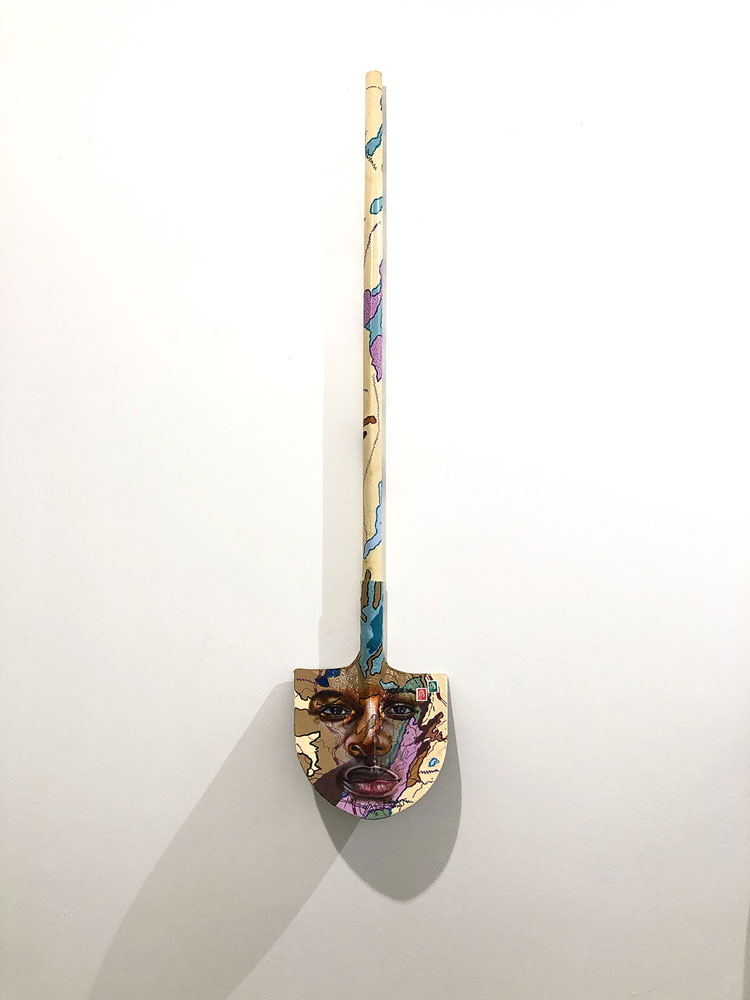
Jean David Nkot. Les âmes des sous-sols #6, 2021. Mixed media on shovel, 135 x 30 cm. Courtesy AFIKARIS Gallery.
AMc: How important is it to you to represent aspects of your country and its people in your work?
JDN: For me, it is more important to deal with situations that do not solely happen where I am. I feed my work with the stories of the people I meet. As I can’t collect testimonies from people in Congo, for example, I use the young people of my neighbourhood to build what I call crypto portraits – a way of talking about yourself through others. Thus, I use the faces of people in Cameroon to tell the stories of people in other countries. The result is a mixture of what arose from my discussion with the person depicted, my personal feelings and my research on a specific topic.
AMc: How did this new series develop from your previous focus on the topic of migration? Is there a linear progression or link?
JDN: My work has always been about the human condition, but my interest is now also on the notion of resilience. I want to show the combat of these people who are fighting for a better life. More than “solely” representing people suffering, I try to represent their attitude and their dignity. I want to show that, even if every day is hard, it is worth being alive. I wanted to share the story of the people who stayed in their country and try hard to make a better life in spite of the difficulties. The mismanagement of mineral resources by states is the backdrop to this resilience. There is a stark contrast between what is happening, and how young people always find a way to cope, despite everything.
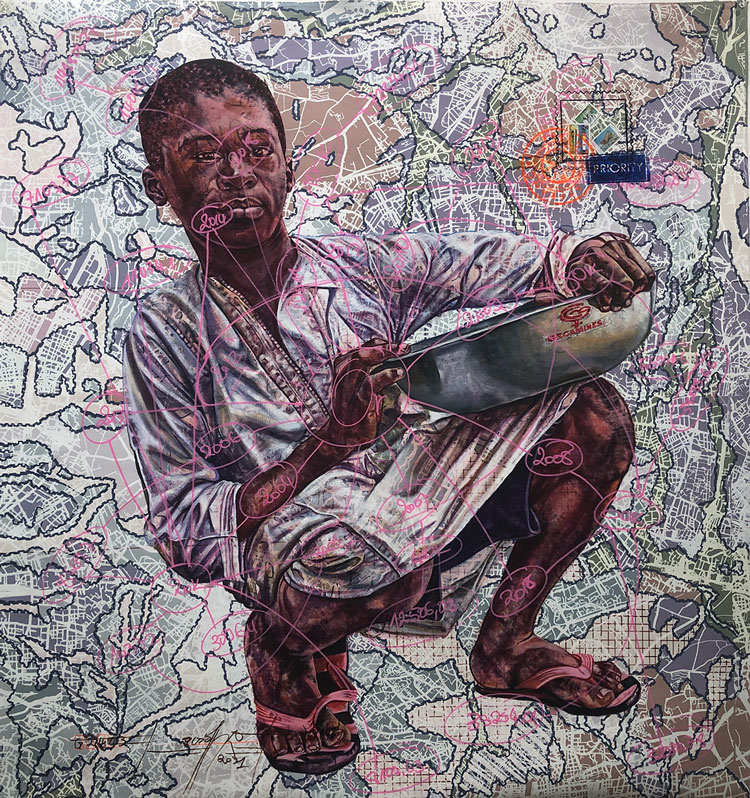
Jean David Nkot. @PPTE/ production/ or/.gmail.com, 2021. Acrylic, silkscreen printing and posca on canvas, 110 x 120 cm. Courtesy AFIKARIS Gallery.
The link is my desire to embody the human condition, to shed light on the people ignored by society. The topic changes depending on my research. I’m currently focusing on raw materials. While this series is centred on mining, my practice deals with agriculture and all the commodities that are produced in Africa but reserved for exportation.
AMc: Tell me about the scale of your works. Some are as large as 2 x 3 metres, whereas some are much smaller and more intimate. Does the scale affect the way you approach the work and what you include in the composition?
JDN: The scale is not predefined. It depends on what I want to represent and the impact I want to elicit. I use large-scale canvases to showcase several characters from head to toe. I want to give space to bodies, to allow them to move freely. That’s why my smaller sizes are dedicated to closeup portraits. I want to make my subject imposing. I want to highlight and magnify what is infinitely small. It is about how I make visible those who are rendered invisible by the system. I want to show how these bodies and spaces that used to be neglected can take over the canvas, the visual field of the viewer. The purpose is not to expose the artwork but the spectator. It is to trigger feelings and emotions in front of this immensity without any possibility of escape. I’m interested in how the viewer digests the information, and how he is invited to think about the questions raised.
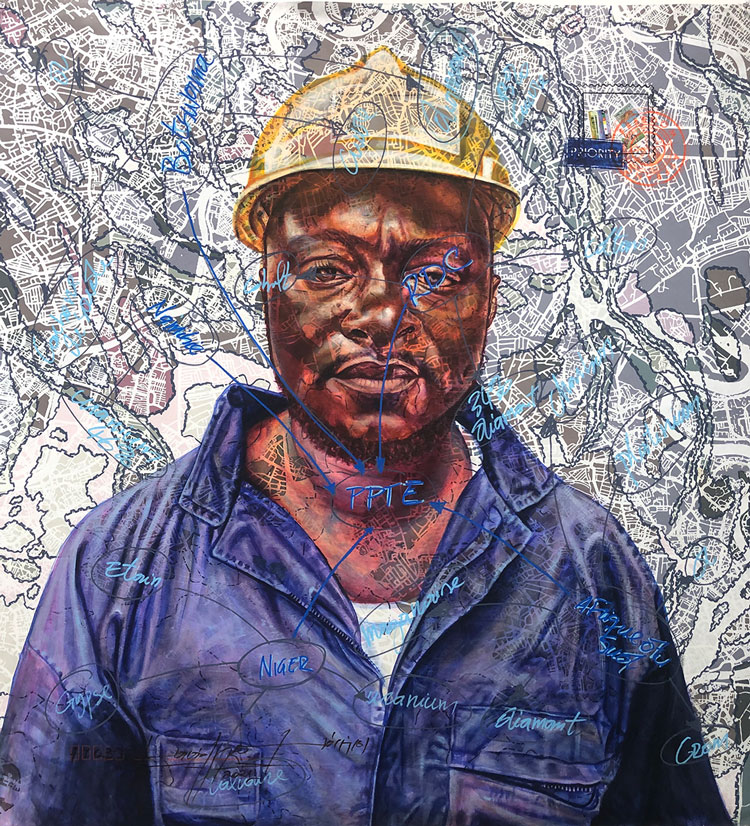
Jean David Nkot. Po.Box PPTE.cm, 2021. Acrylic, silkscreen printing and posca on canvas, 110 x 120 cm. Courtesy AFIKARIS Gallery.
Hence, the scale of the composition of my works depends on the format. I want to focus on my characters and give them sufficient space to express themselves and tell their story, so the size of the canvas varies according to the angle and proximity adopted.
AMc: How do you go about composing a work? Can you talk me through your process? Do you sketch the figures from life, memory, or photographs? How do you build up the layers, and what materials and mediums do you use?
JDN: My works are born out of an exchange with people, but also from personal research. I use data to “embellish” my maps and contribute to the history of the main characters on my canvas. Maps evoke cities passed through as well as cities dreamed of. Sometimes they analyse geopolitical situations influencing the life of my subjects. Each artwork is a piece of history, the history of the individual I’m painting. Each canvas talks differently about my subject, and how I exchange with him.
I paint from photography, but my technique has evolved since the beginning. In the past, I represented my subject first, then I used to draw the map around it. Now, I make the map, then the character appears on it. In this way, I can play with transparency and reach the essential. I mainly work with acrylic and Indian ink. Sometimes the map is silkscreened. Finally, I add comments and symbols with posca.
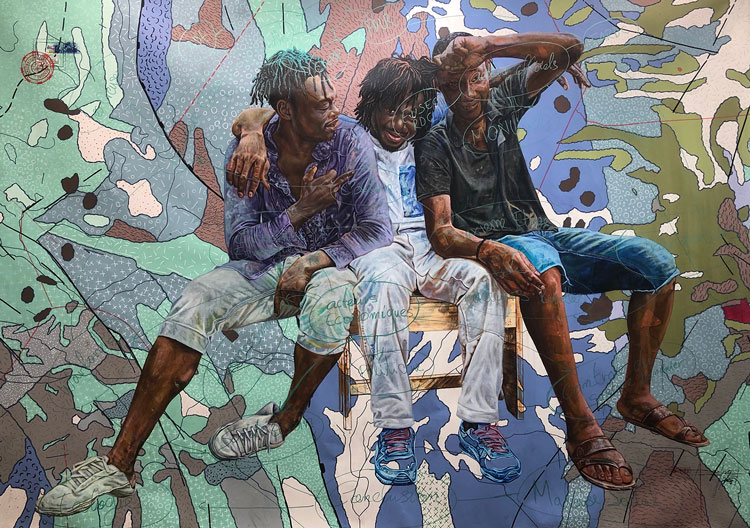
Jean David Nkot. Po.Box The hope of the soul, 2021. Acrylic, silkscreen printing, posca and collage on canvas, 200 x 300 cm. Courtesy AFIKARIS Gallery.
AMc: What is posca? And can you talk a little about why and when you choose one technique or medium over another?
JDN: Posca is a type of felt pen. It is more precise and easier to use than a brush to add comments and write names directly on to the canvas. When I work with silkscreen, I obtain more geographically accurate maps, recalling abstract plans, such as the ones found in the subway. When the background of the canvas is to be silkscreened, I use coloured Indian ink first of all. It provides fluidity and movement. When I paint my characters, I always go from dark colours to brighter colours, from the dark to the light. In this case, black Indian ink gives more intensity to the portrait.
AMc: How important is it to you that a viewer can read the different layers? What do you want someone to take away from a visit to your exhibition?
JDN: I think it is important to enter my work progressively. The first thing you see is the colour. The meaning comes afterwards. Earlier, my works were quite brutal. You did not have time to allow your vision to adjust. You were plunged directly into the violence and the despair of my characters. Now, I introduce the violence of the topic step by step. The viewer is first attracted by the aesthetics of the composition, and the colours, before being invited to understand what is really happening, helped by the data and words overlaying the canvas. The viewer discovers the deeper meaning of my work through the third layer: the molecule map.
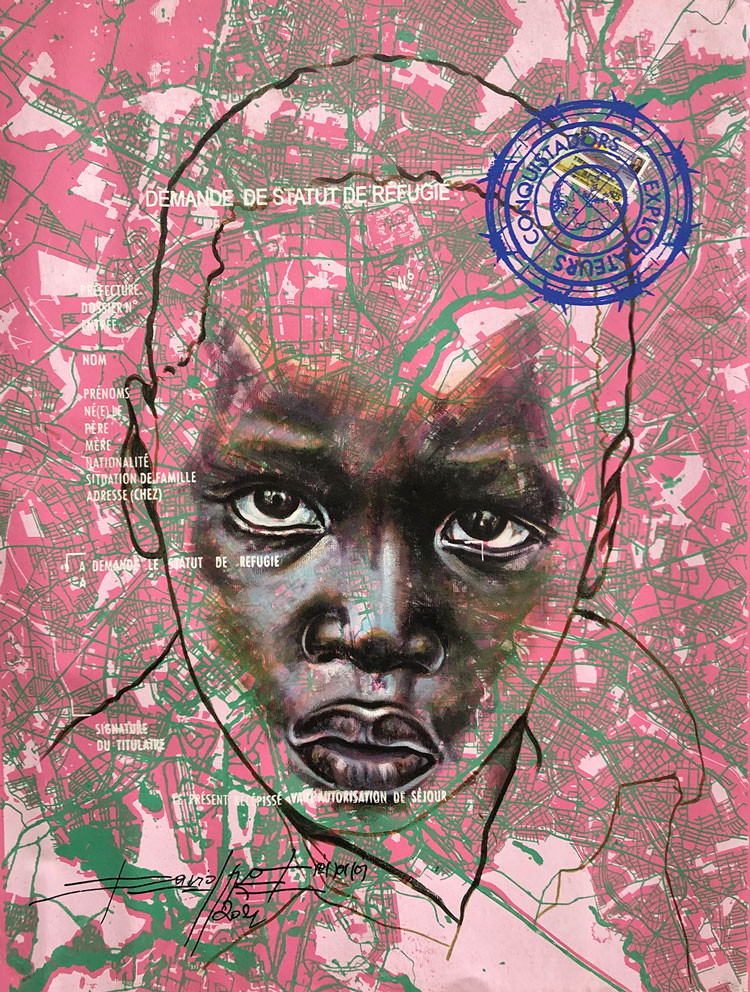
Jean David Nkot. www.look of hopes@.com #4, 2021. Acrylic, posca and silkscreen printing on canvas, 65 x 50 cm. Courtesy AFIKARIS Gallery.
I was taught that artworks need to have an entrance as well as an exit. The colours and general aspects embody this entrance, while the meaning is the exit.
I want everyone to understand the reality of what is happening in different territories. I want to shake people’s consciences and make them react. This exhibition is, above all, a message of hope, an invitation to go beyond our own limitations; despite our differences, to be inspired by other people’s stories and life trajectories.
AMc: To coincide with the exhibition, AFIKARIS Gallery is also producing the first monograph of your work. Presumably this contains essays explaining and contextualising your work. Would you ideally have viewers read this as well as viewing the work?
JDN: This monograph reflects my work. It brings together different points of view, as well as my own explanations. Of course, opening a book is not at all the same thing as seeing a canvas in real life. Although the book supports my work, it cannot reproduce the scale of my canvases. Thus, I think reading this monograph and looking at my canvases are two different things. They go together, but one cannot replace the other.
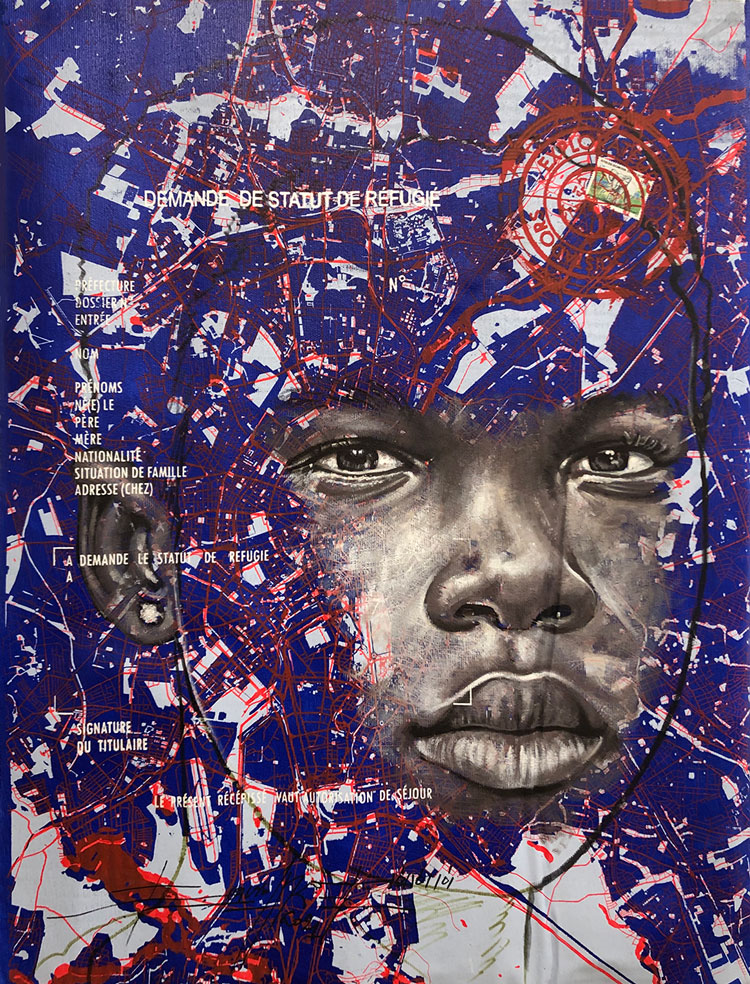
Jean David Nkot. www.look of hopes@.com #5, 2021. Acrylic, posca and silkscreen printing on canvas, 65 x 50 cm. Courtesy AFIKARIS Gallery.
AMc: Who or what do you turn to for artistic inspiration, both in terms of art history, but also beyond that?
JDN: Hervé Youmbi and Jean Jacques Kanté are sources of inspiration for me in terms of aesthetics, colour and composition. Concerning the manner in which I treat my subject, and the violence of the body, I’m inspired by Francis Bacon, Philippe Pasqua, Jenny Saville and Marlene Dumas.
AMc: Can you say a little about your artistic training?
JDN: I joined the Mbalmayo Artistic Formation Institute in 2006. After having obtained my baccalaureate there in 2010, I graduated from the Institute of Fine Arts in Foumban in 2015, with a bachelor’s degree in fine arts. Throughout my training, I received several artistic distinctions (best sculptor, installer and painter). In 2017, I joined the post-master’s programme “Moving Frontiers”, organised by the National School of Arts of Paris-Cergy on the theme of borders. I also learned a lot by visiting the workshops of other Cameroonian artists such as Salifou Lindou, Hervé Youmbi, Jean Jacques Kanté, Pascal Kenfack and Ruth Belinga.
AMc: You have been working with AFIKARIS Gallery since it was founded in 2018. What does it mean to you that it now has a physical gallery space and that you are the first artist to show there?
JDN: The bonds I have with the gallery go beyond basic business relationships. The gallery is made up of individuals working together. They are my friends, and I consider them to be my family. I am happy and proud to be part of their evolution, that we have surmounted difficulties and always found ways to progress. We have grown up together, hand in hand. It is teamwork. It is all about good vibes and mutual love.
• Jean David Nkot: Human@Condition is at AFIKARIS Gallery, Paris, from 29 May to 7 July 2021.